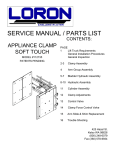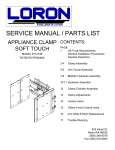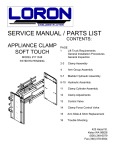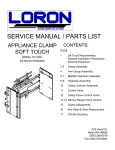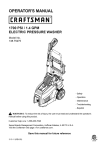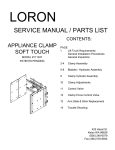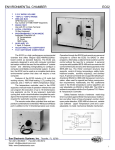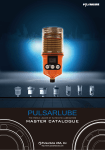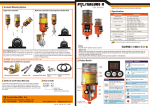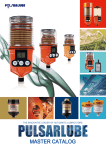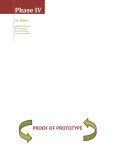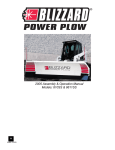Download SERVICE MANUAL / PARTS LIST
Transcript
SERVICE MANUAL / PARTS LIST BASIC CLAMP BOLT-ON ARMS CONTENTS: PAGE 1 Lift Truck Requirements General Installation Procedures General Inspection 2-3 Basic Clamp Parts Group 4 Clamp Cylinder Assembly & Service 5 Valve Assembly 6 Adjusting Relief Pressure 7 Arm Slide & Shim Replacement 8 Troubleshooting Guide 425 Hazel St. Kelso WA 98626 (800) 248-6079 Fax (360) 578-9934 LIFT TRUCK REQUIREMENTS CAPACITY CLAMP HYDRAULICS Capacity shown on the Clamp name plate is for the Clamp only. the combined truck and Clamp capacity is provided by the lift truck manufacturer. Recommended Truck Pressure: 1700 to 2500 PSI (115 to 170 bar) Oil volume: 6-10 GPM (22.5 to 38 l/min) Hydraulic fluid: petroleum based hydraulic fluid only Hydraulic supply group: includes hoses and take-up - one set for each function Auxiliary valve: 2 Function (Side Shift & Clamp) = a double auxiliary valve GENERAL INSTALLATION PROCEDURES 1. Make sure that the attachment centering lug is completely seated in truck carriage center notch. 2. Clearance between the lower retainers that hold the attachment to the truck lower carriage bar should be as shown below. .13" (3.2mm) MAXIMUM TRUCK LOWER CARRIAGE BAR LOWER RETAINER 3. Attach truck supply group (take-up) to clamp valve on attachment base. 4. Standing clear of the Clamp attachment cycle the attachment in and out several times. Use caution because partially filled hydraulic lines may cause erratic movement. GENERAL INSPECTION AND MAINTENANCE 1. Check all hydraulic fittings, hoses, cylinders and valves for leakages - repair or replace as required 2. Check hoses for pinch points and signs of wear. Replace worn hoses with LORON hose or Parker Parflex # 560 wire - reinforced hose only. 3. All bolts should be checked and tightened as required. See Torque Note page 2. 4. Check lower retainer clearance - see item 2 in General Installation Procedures above. A shim may be tack-welded to the bottom of the lower retainers to tighten the clearance if necessary. 1 BASIC CLAMP PARTS GROUP - 1 TORQUE SPECIFICATION (LUBRICATED) 1 1.00" DIA BOLT - 675 FT-LBS (93.4KG-M) 9 .88" DIA BOLT - 450 FT-LBS (62.2 KG-M) 10 SEE CLEARANCE NOTE PAGE 4 12 11 2 13 14 7 15 16 17 18 19 6 3 5 8 4 2 BASIC CLAMP PARTS GROUP - 2 L20 & L25 CLAMPS # QTY 1 PART # DESCRIPTION 1 SEE CUSTOMER PACKET FRAME WELDMENT 2 2 SEE CUSTOMER PACKET CYLINDER ASSEMBLY 3 4 SEE CUSTOMER PACKET ARM WELDMENT 4 8 SEE CUSTOMER PACKET SHIM 5 4 SEE CUSTOMER PACKET FLAT SLIDE 6 8 SEE CUSTOMER PACKET ANGLE SLIDE 7 1 SEE CUSTOMER PACKET FRONT COVER 8 12 103752 SLIDE BUTTON L35 & L50 CLAMPS # QTY 1 PART # DESCRIPTION 1 SEE CUSTOMER PACKET FRAME WELDMENT 2 2 SEE CUSTOMER PACKET CYLINDER ASSEMBLY 3 4 SEE CUSTOMER PACKET ARM WELDMENT 4 8 SEE CUSTOMER PACKET SHIM 5 4 SEE CUSTOMER PACKET FLAT SLIDE 6 8 SEE CUSTOMER PACKET ANGLE SLIDE 7 1 SEE CUSTOMER PACKET FRONT COVER 8 12 107997 SLIDE BUTTON L20 - L50 CLAMPS - COMMON PARTS # QTY 9 PART # DESCRIPTION 4 100574.86 COTTER PIN 10 4 101333 SLOTTED NUT 11 4 100047 HARDENED WASHER 12 4 101324 SPHERICAL BEARING 13 2 1C.0612 HEX HEAD BOLT 14 2 4E.06 LOCK WASHER 15 2 100572.060 BALL-LOCK PIN 16 2 101098 LOWER RETAINER 17 2 16E.06 LOCK WASHER 18 2 11G.0612 SOCKETHEAD BOLT 19 2 100077.3 ROUND BAR 3 CYLINDER ASSEMBLY 9 10 11 15 13 SAE #6 O-RING PORTS 4 12 2 1 CLEARANCE NOTE: .03/.06 EACH CYLINDER END ADJUST SLOTTED NUT TO ALLOW FOR CLEARANCE AS SHOWN. INSERT COTTER PIN AFTER ADJUSTMENT. L35 & L50 CLAMP CYLINDER # 6 14 8 CYLINDER ANCHOR REF. 3 7 QTY PART # L20 & L25 CLAMP CYLINDER DESCRIPTION 1 CONSULT FACTORY CYLINDER ASSEMBLY 1 1 CONSULT FACTORY TUBE 2 1 3 # QTY PART # DESCRIPTION 1 CONSULT FACTORY CYLINDER ASSEMBLY 1 1 CONSULT FACTORY TUBE CONSULT FACTORY ROD 2 1 CONSULT FACTORY ROD 1 100021 PISTON 3 1 101256 PISTON 4 1 100020 GLAND 4 1 101254 GLAND 5 1 101036 SEAL KIT (NOT SHOWN) 5 1 101261 SEAL KIT (NOT SHOWN) 6 1 101035 MODIFIED ESNA NUT 6 1 101035 MODIFIED ESNA NUT 7 1 100032.107 POLY PAK LSP 7 1 100032.095 POLY PAK LSP 8 1 100031.059 POLY PAK LSP 8 1 100031.059 POLY PAK LSP 9 1 100028.316 BACK-UP O-RING 9 1 100028.314 BACK-UP O-RING 10 1 100029.316 O-RING LSP 10 1 100029.314 O-RING LSP 11 1 100033 WEAR RING LSP 11 1 101260 WEAR RING LSP 12 1 101034.6 WIPER LSP 12 1 101034.6 WIPER LSP 13 1 100027.1 LOCKWIRE 13 1 100027.2 LOCKWIRE 14 1 100029.203 O-RING LSP 14 1 100029.203 O-RING LSP 15 1 CONSULT FACTORY SPACER 15 1 CONSULT FACTORY SPACER CYLINDER SERVICE Prior to assembly lubricate seals, cylinder bore and rod with STP. Inspect all parts for scratches, nicks and gouges- -replace all damaged components. Inspect cylinder bore and rod for scoring- -replace if scored Avoid damage to seal grooves- -use a dull screwdriver for seal removal Torque piston nut to 200 FT/LBS. 4 SIDE SHIFTING VALVE 103813 FLOW DIVIDER TORQUE 10-12 FT/BLS 104711 SEAL KIT 104721 ORIFICE G 103815 BIDIRECTIONAL RELIEF TOQUE TO 35/40 FT/LBS 104716 SEAL KIT F B 101419.03 #4 SAE O-RING PLUGS A E D C 103815.1 BIDIRECTIONAL RELIEF SEE103815 ABOVE FOR SEAL KIT AND TORQUE NOTE 103814 P.O. CHECK TORQUE 35/40 FT/LBS 104715 SEAL KIT NOTE: 1. Lubricate threads & seals prior to assembly. 2. For VALVE pressure changes See page 7. HYDRAULIC SCHEMATIC 100011 SIDE SHIFTING VALVE ASSEMBLY (Includes all cartridges & plugs) C1 C4 C3 C2 SS2 103815 850PSI B C D QTY PART # 103814 (3) DESCRIPTION 1 103815 RELIEF CARRIAGE 1 103813 FLOW DIVIDER / COMBINER 3 103814 P.O. CHECK CARTRIDGES 1 103815.1 RELIEF CARTRIDGE 14 101419.03 #4 SAE O-RING PLUG LSP 104721 ORIFICE 1 E F G 103813 104721 103815.1 1700PSI 5 A SS1 ADJUSTING RELIEF PRESSURE WARNING: RELEASE TRUCK PRESSURE PRIOR TO SERVICING VALVE BY TURNING THE TRUCK OFF AND "WORKING" THE SIDE SHIFT AND CLAMP FUNCTION CONTROLS REMOVE CAP - REPLACE CAP PRIOR TO PRESSURIZING SYSTEM TURN ADJUSTMENT: COUNTERCLOCKWISE TO DECREASE PRESSURE CLOCKWISE TO INCREASE PRESSURE DO NOT EXCEED 2000 PSI (136 BAR) ADJUSTING SYSTEM PRESSURE 1. Release system pressure prior to servicing valve by turning the truck off and working the side shift and clamp function controls several times. 2. Prior to adjusting system pressure, disconnect the hoses from the clamp valve at the "open" and "close" ports. Install a separate in-line tee with a short hose and a pressure gauge that is calibrated to 5000 psi (340 bar) in each port (two required). Reconnect hoses. 3. Measure system pressure by securely clamping a load or close the clamp arms all the way and hold the control and hold the control lever in the closed (clamped) position. The actual clamping pressure is the difference between the pressure shown on the gauge in the "open" port subtracted from the pressure shown on the "close" port gauge. 4. Release system pressure (see step 1). Remove cap on bidirectional valve (item #4 on side shifting valve) and adjust cartridge no more than one quarter turn. Replace cap prior to pressurizing system. Repeat until desired pressure setting is achieved. Do not exceed 2000 psi (136 bar) clamping pressure. ADJUSTING BY-PASS PRESSURE 1. If on arm bottoms out and the other moves more then 3" (76mm) before opening fully, increase by-pass relief pressure. If one arm bottoms out and the other dose not open fully, decrease by-pass pressure. 2. To adjust by-pass relief pressure, release system pressure prior to servicing valve by turning the truck off and working the side shift and clamp function control several times. 3. Remove cap on bidirectional valve (item #1 on side shifting valve) and adjust cartridge no more than one quarter turn. Replace cap prior to pressurizing system. Repeat until desired pressure setting is archived. Do not exceed 2000 psi (136 bar) 6 ARM SLIDE & SHIM REPLACEMENT 1. To replace the slides extend the arms to the fully open position. Release system pressure prior to removing the arms by turning the truck off and working the side shift and clamp function controls several times. 2. Support the arm with an overhead crane or lift truck. Be sure to secure the chain or sling in a manner that prevents the arm from falling out of the chain or sling when hanging free of the clamp frame. 3. Remove the cotter pin, slotted nut and spherical bearing from the end of the clamp cylinder rod. Keeping hands and feet clear, carefully slide the clamp arm off of the clamp frame. 4. Install the arm on the clamp frame ensuring that the arm moves freely without excessive binding. If the arm is too loose or too tight add or remove shims as required. Once the clearance is satisfactory insert the cylinder rod into the cylinder anchor on the arm. Install the spherical bearing, nut and cotter pin onto the cylinder rod end. Be sure to leave .03" - .06" (.7mm to 1.5mm) clearance to allow the cylinder to "float" on it's mountings (see page 4).Remove the cotter pin, slotted nut and spherical bearing from the end of the clamp cylinder rod. Keeping hands and feet clear, carefully slide the clamp arm off of the clamp frame. BLOCK: FOR L20 CLAMP MODELS 2" X 2" X 3" LONG (50.8mm X 50.8 mm X 76mm) FOR L35 CLAMP MODELS 2.25" X 2.25" X 3" LONG (57.2mm X 57.2mm X 76mm) ARM CLAMP FRAME ARM BAR 5. Inspect slides and slide buttons for wear. Slides may be rotated end-for-end and re-used if excessively worn on the outer end only. Extra shims may be used to tighten operating clearance on slightly worn slides. Replace any slides worn to less than .06" (1.5mm) thick or any slide that is deeply scored or broken. 6. To aid in replacing the slides a block may be fashioned of wood or another convenient material to the dimensions shown above. The block is inserted in the end of the arm to hold the slides, shims and buttons in position while the arm is inserted over the arm bars on the clamp frame. The block is expelled out the opposite end of the arm as the arm is pushed onto the frame. 7. Prior to installing the arm the block may be used to determine the number of shims to place under the slides. Adjust the clearance between the slides and the block to provide approximately .06" (1.5mm) running clearance between the slides and arm when installed. 7 TROUBLE SHOOTING GUIDE LOADS SLIPPING OR DROPPING POSSIBLE CAUSES SOLUTIONS 1. Valve cartridges not sufficiently tight 1. Tighten all cartridges to torque values shown on page 6 2. System relief pressure set too low 2. See Adjusting System Pressure page 7 3. Internal leakage in cylinder 3. Replace Cylinder seals. If tube, piston or rod scored replace with new parts. 4. Incorrect clamp pad size or load not fully engaged in clamp arms 4. Be sure the clamp pads are correctly sized and the load for the load and the load is positioned fully in the clamp arms 5. Pad camber set incorrectly 5. Shim pads to change camber 6. Load to heavy for clamp capacity 6. Consult factory 7. Load may not by stacked correctly or may need to be unitized 7. Re-stack or unitize load (shrink wrap) 8. Bent arms or contact pads 8. Consult factory CRUSHING LOADS POSSIBLE CAUSES SOLUTIONS 1. System relief pressure set too high 1. See Adjusting System Pressure page 7 2. Operator over-working (milking) control valve 2. Once the pad contact the load, clamp the load in one even motion - do not over-work the valve 3. Bent arms or contact pads 3. Consult factory 4. Pad camber set incorrectly 4. Shim pads to change camber 5. Variable loads that require different clamping pressures 5. Install a 4-position pressure regulator on truck cowl consult factory for part number and availability 8










